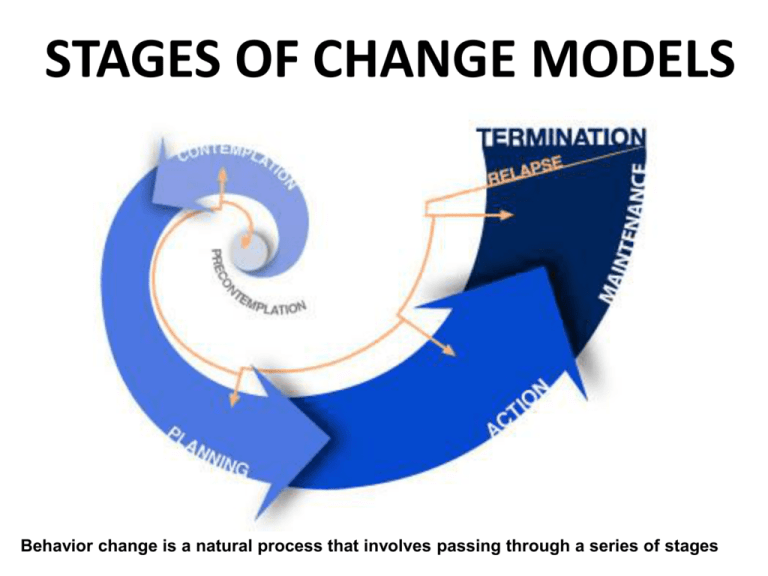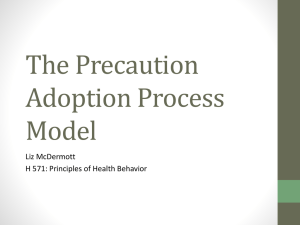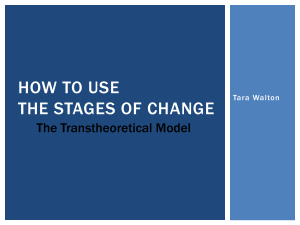H571 Week 4 - Stages of Change Models
advertisement

STAGES OF CHANGE MODELS Behavior change is a natural process that involves passing through a series of stages Agenda for Today • Quiz • Monica: – Transtheoretical Model, Stages of Change • Kristty: – TTM – Processes of Change • Liz: – Precaution Adoption Process Model • Miyuki, Chidi & Bhakti: – Bridle et al., 2005 review • Fran: – West, 2005 Transtheoretical Model of Change Transtheoretical Model of Change (Stages of Change) • Transtheoretical Model of Change was originally explained by Prochaska & DiClemente, 1983. • The TMC is a model of intentional change. This model focuses on the decision making of the individual. • The model describes how people modify a problem behavior or acquire a positive behavior. • The TMC is a type of value-expectancy theory Core constructs The core constructs of the TMC are: • The processes of change (which we will discuss later) • Decisional balance (value-expectancy aspect) • Self-efficacy • Temptation Stages of Change Pre-Contemplation: • People may be in this stage because they are uninformed or under-informed about the consequences of their behavior. or • They may have tried to change a number of times and become demoralized about their ability to change. • Both groups tend to avoid reading, talking or thinking about their high risk behaviors. Contemplation Aware of the pros of changing but are also acutely aware of the cons. This balance between the costs and benefits of changing can keep people stuck in this stage for long periods of time. Preparation • This is the stage in which people are intending to take action in the immediate future, usually measured as the next month. They have typically taken some significant action in the past year. • Individuals develop a plan of by joining a health education class, consulting a counselor, talking to their physician, buying a self-help book or nicotine replacement. Action This is the stage in which people have made specific overt modifications in their life-styles within the past six months. Since action is observable, behavior change often has been equated with action. But in the TTM, Action is only one of five stages. • Not all modifications of behavior count as action in this model. People must attain a criterion that scientists and professionals agree is sufficient to reduce risks for disease. Maintenance This is the stage in which people are working to prevent relapse but they do not apply change processes as frequently as do people in action. They are less tempted to relapse and increasingly more confident that they can continue their change. Relapse Regression occurs when an individual reverts to an earlier stage of change. Relapse is one form of regression, involving regression from Action or Maintenance to an earlier stage. However, people can regress from any stage to an earlier stage. Relapse tends to be the rule when action is taken for most health behavior problems. For smoking and exercise only about 15% of people regress all the way to the Precontemplation stage. Movement through the stages The amount of time a person is in each stage and the order in which a person experiences each stage can vary greatly. Cycling and re-cycling • Behavior change usually involves multiple attempts and people may revert to a previous stage at any time • The process of cycling and re-cycling through the stages a number of times is a critical concept of the theory Decisional Balance • This construct reflects the individual's relative weighing of the pros and cons of changing. • The Decisional Balance scale involves weighting the importance of the Pros and Cons. • A predictable pattern has been observed of how the Pros and Cons relate to the stages of change. For example: In Precontemplation, the Pros of smoking far outweigh the Cons of smoking. In Contemplation, these two scales are more equal. In the advanced stages, the Cons outweigh the Pros. Decisional Balance Stopping an Unhealthy Behavior Starting a Healthy Behavior Starting an exercise program Pros Cons • I would have more energy for my family and friends if I exercised regularly. • Exercising puts me in a better mood for the rest of the day. • I would feel embarrassed if people saw me exercising. More examples?... Self-efficacy/Temptation • The Self-efficacy construct represents the situation specific confidence that people have that they can cope with high-risk situations without relapsing. • This construct was adapted from Bandura's self-efficacy theory. This construct is represented either by a Temptation measure or a Selfefficacy construct. • The Situational Temptation Measure reflects the intensity of urges to engage in a specific behavior when in the midst of difficult situations. It is the converse of self-efficacy and the same set of items can be used to measure both, using different response formats. • Stage Matching: Identifying which stage a person is in can enable the development of targeted interventions. Are you thinking of quitting within the next 6 months? No Yes Precontemplation Have you tried to quit smoking for at least 24 hours in the past year? Yes Preparation No Contemplation Applying the TCM N = 1864 women aged 40-74 were recruited from a staff model HMO and randomly assigned to one of three intervention groups: (a) No Educational Materials, (b) Standard Materials, and (c) Stage-Matched Materials (based on the TCM). The Standard and Stage-Matched groups each received two mailed educational packets after baseline and follow-up telephone interviews. Receipt of mammography after the baseline interview was higher for the Stage-Matched group (63.6%) than for the No Materials group (54.9%; OR = 1.43, 95% CI = 1.10, 1.86). The Standard group did not differ from the No Materials group, but did differ from the Stage-Matched group in multivariate analysis. Activity: Stage Matching 1. Break into groups of about 5. 2. Match statement to stage. 3. A group member will read your statement to the class and explain which stage your group chose. Works Cited Cancer Prevention Research Center. (2000). Detailed Overview of the Transtheoretical Model. URI.edu. Retrieved October 23, 2013 from http://www.uri.edu/research/cprc/TTM/detailedoverview. htm Current Nursing. (2012). Stages of change model/transtheoretical model (TTM). Retrieved October 23, 2013 from http://currentnursing.com/nursing_theory/transtheoretica l_model.html Rakowski, W., Ehrich, B., Goldstein, M.G., Rimer, B., Pearlma, D.N., Clark, M.A., Velicer, W.F., and Woolverton, H. (1998). Increasing mammography among women aged 40–74 by use of a stage-matched, tailored intervention. Preventive Medicine. 27(5), 748–756. Transtheoretical Model of Change (TMC) Processes of change (POC) Behavior Change 1. ID individual’s stage of change 2. Processes of change • Strategies to promote progression through stages Empirically supported processes 1. Consciousness raising • Increasing awareness of health risks and protective behaviors 2. Dramatic relief • Enhance emotional reaction to health-risk behaviors 3. Self-reevaluation • Visualize oneself and life without health-risk behavior 4. Environmental reevaluation • Does health habit adversely affect others in social environment 5. Self-liberation • Foster the idea one can change and commit to change 6. Helping relationships • Utilize supportive others to promote behavior change 7. Counterconditioning • Substitute healthier behaviors for unhealthy behaviors 8. Contingency management • Reward and punishment 9. Stimulus control • Reduction and addition of cues 10.Social liberation • Change or transcend socially designated norms or practices Stage-matched interventions Stage Transition PC → C Process of Change Consciousness raising, dramatic relief, self-reevaluation, environmental reevaluation C→P Self-reevaluation, environmental reevaluation, self-liberation, self-efficacy, stimulus control P→A Self-liberation, self-efficacy, stimulus control, counterconditioning, helping relationships A→M Stimulus control, counterconditioning, helping relationships, reinforcement management Class Activity • Topic: Self-management blood glucose (SMBG) – a necessary behavior for diabetics is to monitor blood glucose levels, yet is underperformed – How can we change this behavior? • Brainstorm techniques to be used for each processes of change Decisional balance • Janis and Mann (1977) • Pros and cons of changing behavior – Maximize the pros! – Minimize the cons! • Tipping point – Strong principle of progress – Weak principle Self-efficacy • Albert Bandura (1986) • Two components: – Confidence – Temptation • Resilient self-efficacy The TTI Developmental-Ecological System Levels of Causation E Ultimate Underlying Causes Values Environment S ENVIRONMENT Situation Person P P E S P Knowledge Environment S E Distal Predisposing Influences Value Social SelfCom- Role Bonds Control petence Models Eval Mc Att SNB Self Proximal Immediate Predictors Exp NB Will + Skill SNB Know Att Efficacy Intentions Behavior DEVELOPMENT & TIME 33 Precaution Adoption Process Model (PAPM) Theories Evolve • Theories are seldom static • The PAPM is similar to the TMC • The PAPM is the second major stage theory in health promotion • The PAPM describes how someone comes to a decision to adopt a precautionary behavior Precaution Adoption Process Model (PAPM) Unaware of issue Unengaged by issue Deciding about acting Decided not to act Deciding to act Acting Maintenance What is included in a stage theory? • Four basic assumptions of a stage theory – A classification system to define stages – An ordering of stages – Stages that are defined by common barriers within stages – Stages that are defined by different barriers within different stages How is PAPM similar to TMC? • Both theories utilize stage progression • Both theories have a goal of leading to the achievement of a sustainable behavior change • Similar stage names, however… How is PAPM different than TMC? • Stage 1 (precontemplation) in TMC is split into two sub-stages in the PAPM: – 1. Unaware of the issue – 2. Unengaged by the issue • Third assumption of PAPM, barriers of change can be based on three things: – Not being aware – Not being personally engaged – A rejection of the behavior after failing to attempt to change or rethinking after the issue How is PAPM different than TMC? • PAPM does not prescribe change processes • In the PAPM, successful movement from any stage may be due to any number of intervention techniques • Each population and health behavior in question would warrant varied intervention techniques Key Difference • PAPM emphasizes intrapsychic concepts • Evaluating one’s own attitudes, feelings, behavior at each stage • TMC emphasizes environmental factors • Stimulus control, environmental re-evaluation, social liberation Applying the PAPM Eating veggies is healthy? Aware that eating vegetables is healthy Friend made tasty kale salad, found veg pamphlet at SHS Decided to search online for veggie side dish recipes Testing three new recipes every week Healthy or not, they still don’t taste good I don’t feel any different and I still don’t like vegetables Vegetables become a part of every dinner Applying the PAPM Unaware of issue Unengaged by issue Deciding about acting Decided not to act Deciding to act Acting Maintenance Future of PAPM? • These models, like all in behavior change, are dynamic – continue to evolve • New empirical data are discovered and integrated • Although the PAPM is similar to the TMC, it has additional stages and is a bit more precise • Where is PAPM most applicable? The PAPM and the TTI Article Systematic review of the effectiveness of health behavior interventions based on the transtheoretical model (Bridle et. al., 2005) Resource from http://www.balancedweightmanagement.com/change.htm Stage based theory • Stage based theories propose - Behavior change based on a series of discrete stages - Different barriers at different stages - The most effective interventions (Tailored to individual’s current stage) • TTM (Prochaska & DiClemente, 1983)Constructions - Stage of change Process of change Decision balance Self-efficacy Whether stage based interventions are more effective than non-stage based ones ? • Recent previous reviews : little evidence about effectiveness of TTM based interventions in health related behavior • Three explanations - Including different types of research design - Fundamental differences between health behaviors - Stage movement = Behavior change? Purpose of Study • The purpose of this study - To assess the methodological quality of interventions based on TTM ( collecting only 37 RCT designs) - To determine whether TTM interventions are effective ( analyzing data only using 37 RCT designs) - To examine whether some behaviors are more suitable or amenable to TTM ( Dividing health behaviors into 8 different behaviors) - To investigate whether TTM interventions are effective in stage progression Results • Study quality - Lack of methods for randomization, blinding, and fail to use intention to treat analysis - Implementation assessment (12 out of 37 RCT reported validation) • Evidence of effectiveness - Overall, limited evidence about whether TTM based interventions are more effective • Stage movement - 6 comparisons out of 18 favored stage based interventions Results • Evidence of effectiveness according to types of behavior - Smoking cessation : 4 trials out of 12 favored stage-based interventions. - Physical activity : 1 trials out of 6 favored. - Dietary change : 2 comparisons out of 6 favored. - Multiple lifestyle changes : 1 comparison out of 7 favored. - Screening mammography : 2 comparisons out of 3 favored. - Treatment adherence : 1 trials out of 1 favored. - Prevention : none trials favored. Discussion • Overall conclusions - Common limitations in the methodological quality - Only limited evidence for effectiveness of TTM based interventions - No evidence for effectiveness on the behavior being targeted - Little evidence for effectiveness on promoting stage movement • Two issues that contributed the lack of evidence about TTM interventions - Lack of model specification - Poor application Discussion • Lack of model specification - Process of change fail to specify the process that related to particular stages * General views : Experiential process of change – early stages Behavioral process of change - later stages - Fail to predict about the nature of the barriers themselves - Consistent with continuous stages rather than discrete stages Discussion • Poor application - Inappropriate interventions design * tailored only to “stage of change” neglecting other variables * Stage of change – not theory but a single variable - Inappropriate intervention delivery * Inaccurate identification for an individual’s readiness to change * Interventions that reflect changes in the individual’s readiness to change - Static intervention (only one point in time) * Repeated and evolving interventions Time for a change: putting the Trantheoretical (Stages of Change) Model to rest Robert West Overview of Transtheoretical Model (TTM) • Individuals belong to one of five (or six) stages – Precontemplation – Contemplation – Preparation – Action – Maintenance – Termination (in some versions) • Interventions can target people in specific stages Problems with the Transtheoretical Model (TTM) Concept of Stages • Arbitrary dividing lines • Confusing stage definitions – Based on days and previous attempts at behavior change – Not based on readiness to change Model as a Whole • Based on the assumption that individuals make thought-out plans – Intentions to make behavior changes are not always based on conscious decision making and do not always involve clear planning – Neglects the role of reward and punishment THE THEORY OF TRIADIC INFLUENCE Levels of Causation Intrapersonal Stream Biological/Nature BIOLOGY/ PERSONALITY Ultimate Causes 1 Social/ Personal Nexus 2 Sense of Self/Control Distal Influences 7 13 8 h Skills: Social+General 14 Proximal Predictors b c B C Others’ Beh & Atts 9 i k j l m u d e n 16 SOCIAL NORMATIVE BELIEFS o 11 w 20 q Values/ Evaluations x v 6 Interactions w/ Social Instit’s p Perceived Norms 15 5 f 10 Motivation to Comply s CULTURAL ENVIRONMENT 4 Interpersonal Bonding 19 A Nurture/Cultural 3 SELF-EFFICACY t BEHAVIORAL CONTROL Affect and Cognitions Cultural/Attitudinal Stream SOCIAL SITUATION a Social Competence g Self Determination Expectancies & Evaluations Decisions Social/Normative Stream Information/ Opportunities Knowledge/ Expectancies 17 F 21 I 22 Trial Behavior EXPERIENCES: Expectancies -- Social Reinforcements -- Psychological/Physiological Experiences 18 ATTITUDES TOWARD THE BEHAVIOR DECISIONS/INTENTIONS D E 12 r 23 J K Related Behaviors H G Model in Practice • Model predicts no more than common sense “However, [the model] says no more than that individuals who are thinking of changing their behaviour are more likely to try to do so than those who are not, or that individuals who are in the process of trying to change are more likely to change than those who are just thinking about it. Put that way, it is simply a statement of the obvious: people who want or plan to do something are obviously more likely to try to do it; and people who try to do something are more likely to succeed than those who do not” Why the Model Should be Abandoned Promotes Poor Interventions • Individuals at various stages may be excluded from potentially effective interventions • Creates interventions aimed at helping people “move along stages” rather than changing their behavior Next Steps New Model • Should include the ways people can change with apparent suddenness • Should encompass decision-making and motivational processes • State of readiness to change Where did West go with this? • PRIME Theory of Motivation (West, 2006) Another View of PRIME The best View of the PRIME Theory of Motivation West’s foray into Chaos Theory: Bifurcation at a Cusp







